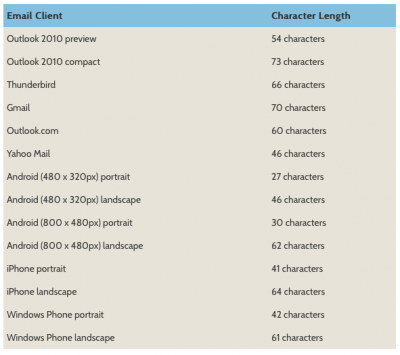

Subject lines are your first point of contact with new customers, new subscribers, and are the first touch point for any top of the funnel deals. You know what they say, you never get a second chance to make a first impression! You can do a million and a half things to make your emails great – perfected copy, gorgeous images, an irresistible CTA – but if your subject line isn’t up to par, none of that effort will matter because your email won’t even get opened in the first place.
Below, we will go through a few key strategies that you can utilize in order to make your email subject lines POP!
Before we get started, a quick exercise – open your email on your phone or computer and quickly look through the last 50 emails you have received. Do any of the subject lines really speak to you? Do you have the urge to open any of the emails? Which emails have you already opened today? Did you open a non-work
related email or one from a sender you usually ignore? Take note of the subject lines. Do you see any similarities between them? What kinds of tactics do you think are being employed for each one? An important tactic to use when writing subject lines is to self-reflect; if I had received this email, would the subject line have made me want to open it? Consider this as you continue reading.
First off – keep it short and sweet
Tell me, when you were looking through your own emails just now, how many of the subject lines for emails that you opened or were drawn to either cut off mid-sentence or ended with an ellipsis (…)? My guess is not very many. “Short, sweet, and to the point” is a well-known marketing and sales tactic and applies heavily to email subject lines as well. The whole purpose of the subject line is to entice your potential customer into clicking on your email and learning more about your product, so you have to pique their curiosity and not give them too much information right off the bat – make them work for it! Additionally, the email is much more appealing when introduced by a full thought instead of a fragmented sentence. “New items in stock” sounds much better than “Come check out all of the new items we have in st…”

It is especially critical to be aware of the increasingly large part that mobile email usage has begun to play this day in age. According to a study done by SuperOffice, email opens on mobile devices increased by 34% from 2011 to 2018 and in 2018, 61% of emails were opened on a mobile device. This is significant, especially because the maximum viewable subject line length is often almost half of that on desktop clients.
Keep your email out of the spam folder
Avoiding the automatic filter
Almost every email client has a built-in spam filter that was developed by multiple developers that are meant to “catch” potentially spammy emails based on a set of criteria before they can make it to your normal inbox. They are complex and include many elements such as checking the HTML coding, from address, and content of incoming emails, but the majority also include a long list of specific words and terms that typically indicate a malicious email. Below is a short list of some terms that have a high probability of being filtered (via OptinMonster):
|
|
Many of these terms you may not realize you have been using, and if you have had poor email performance in the past this may be why.
Additionally, using excessive exclamation marks as well as too many capitalized letters can not only trigger the spam filter but if the message makes it through is incredibly off-putting and often times “looks” like spam to the receiver. Think, did any of the emails that you noted from your own inbox have lots of capital letters, exclamation points, or contain any of the above terms? My bet is probably not.
CAN-SPAM
In 2003, the Controlling the Assault of Non-Solicited Pornography And Marketing (CAN-SPAM) Act was signed into law, establishing the first national set of standards for the sending of commercial emails, essentially setting a standard for determining what kinds of emails are considered “spam” and defining their legality (they’re not). As part of this act, a precedent was set for which elements in an email’s subject line indicates that the correspondence is malicious, and that rule is often how spam filters are set up, along with other rules.
According to the act, it is actually against the law to include intentionally misleading text in your subject line in order to make them open your message. This includes examples such as:
- URGENT – IMMEDIATE ATTENTION REQUIRED
- Thanks for having us over last night!
- RE: your last email
- Thank you for your order!
While you obviously know better than to turn to shady tactics like this, there can be some grey areas when it comes to deception. For example, if you are trying to share a blog post titled “10 Words to Never Say on Facebook” to your subscribers and your subject line is “10 Reasons to Never Post to Facebook Ever Again” then the email might still make it through spam filters, but may be considered a violation of CAN-SPAM due to its misleading nature.
Draw them in
Now that I’ve spent enough covering things you SHOULDN’T do, it’s time to get into things you SHOULD do to really level up your subject line game.
There are a couple of different ways to hook a reader into clicking on one of your emails, starting simply with effective copy. Far too many email senders believe that subject lines should be strictly informational – for instance, if promoting a blog post, it is all too common to see subject lines that just say “Check out our new blog post.” SNORE! Use this opportunity to really tell a story and draw your reader in, even if all you are trying to do is get them to check out your new blog post. Dig deep into your content and tell less about the what and more about the how. Say your blog post is about improving SEO. A great way to spark curiosity is to ask a question and address a possible issue your reader could be having:
“Have you ever wondered why your site traffic is so low?”
Another tactic is to make a bold statement about your reader that may motivate them to investigate your claims and come to you for solutions. It may sound callous, but it pays off to (lightheartedly) understand the insecurities your ideal buyer personas and use them to your advantage. For instance, if you are again trying to drive traffic to your new blog post about SEO, address a problem that one of your leads might be experiencing:
“There’s a reason why nobody ever visits your website”
It sounds a bit harsh, but you know that’s a link you’d most likely at least click on if you operate a website of your own or for a company.
Other strategies
There are many other ways to really make your subject lines click with your readers such as A/B testing two different lines to see which one performs better as well as experimenting with certain lines sent at different times and to different audience segments. Another incredibly effective tactic is using personalization tokens in your subject line in order to draw readers in when they see their own name. Beware of personalization tokens, though, because they are only really effective when the rest of the line is written well due to the surprisingly impersonal tone that they can often have:
“Michael, have you checked out our blog post yet?”
vs.
“Special blog delivery for Michael, hot off the presses”
Obviously, there are a million different elements that can be utilized in crafting the perfect subject line for your email, and not every rule I outlined absolutely needs to be strictly obeyed. It’s OK to place an exclamation mark or use the word “amazing” every now and then, just be vigilant about how your emails are performing, know your audience, and run tests often. Eventually, you will be able to figure out a style that your audience reacts well to and that you feel good about. Until then, keep on experimenting and most importantly, don’t be a dirty spammer!

